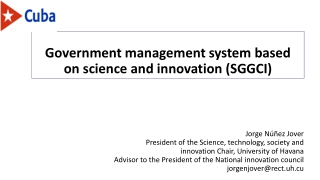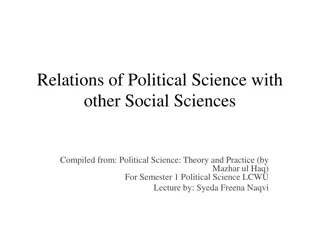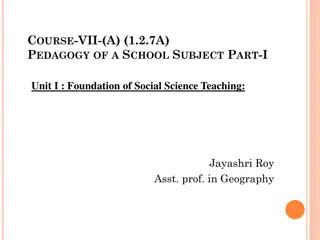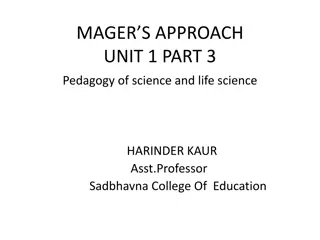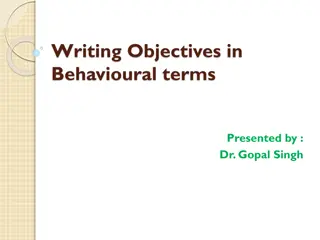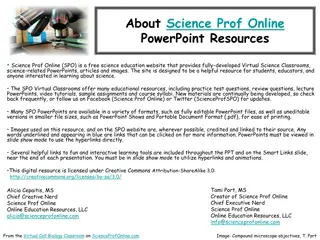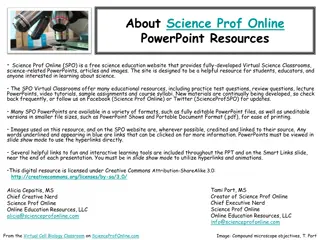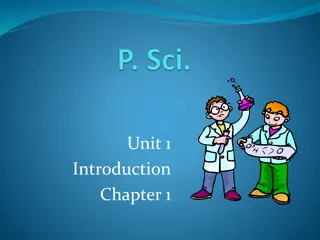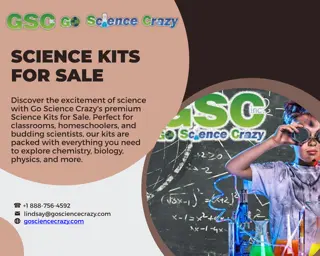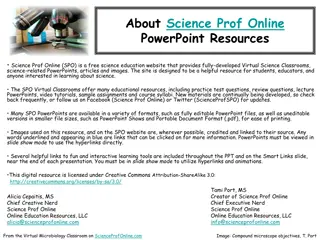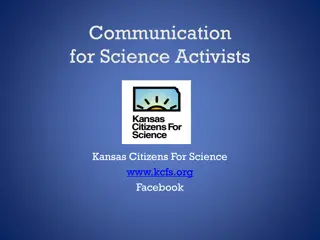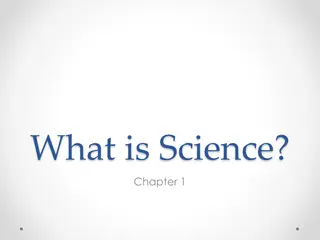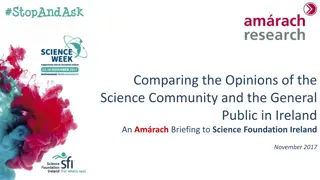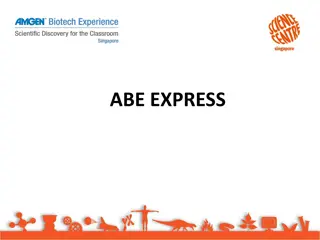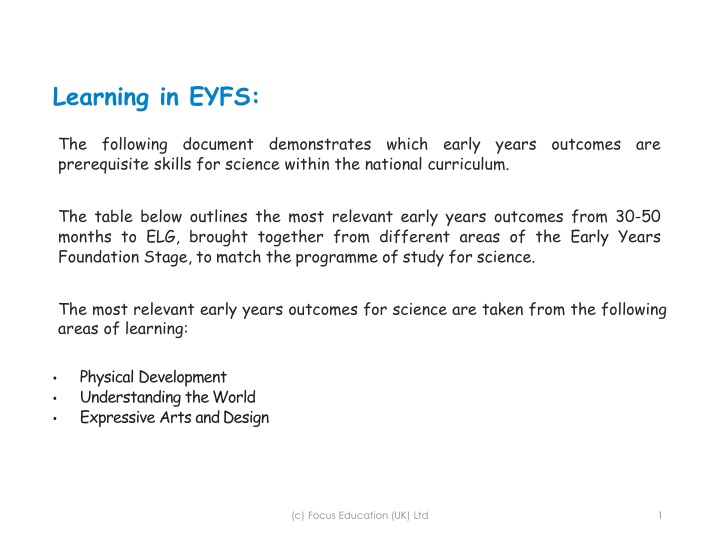
Developing Early Years Science Skills for National Curriculum Alignment
Explore how early years outcomes in physical development, understanding the world, and expressive arts and design lay the foundation for science in the national curriculum. Discover key skills and knowledge progression from 30-50 months to Key Stage 1.
Uploaded on | 2 Views
Download Presentation

Please find below an Image/Link to download the presentation.
The content on the website is provided AS IS for your information and personal use only. It may not be sold, licensed, or shared on other websites without obtaining consent from the author. If you encounter any issues during the download, it is possible that the publisher has removed the file from their server.
You are allowed to download the files provided on this website for personal or commercial use, subject to the condition that they are used lawfully. All files are the property of their respective owners.
The content on the website is provided AS IS for your information and personal use only. It may not be sold, licensed, or shared on other websites without obtaining consent from the author.
E N D
Presentation Transcript
Learning in EYFS: The following document demonstrates which early years outcomes are prerequisite skills for science within the national curriculum. The table below outlines the most relevant early years outcomes from 30-50 months to ELG, brought together from different areas of the Early Years Foundation Stage, to match the programme of study for science. The most relevant early years outcomes for science are taken from the following areas of learning: Physical Development Understanding the World Expressive Arts and Design (c) Focus Education (UK) Ltd 1
Science 30-50 Months Physical Developme nt Understandin g the World Health To observe the effects of physical activity on their bodies. and Self-Care The World To comment and ask questions about aspects of their familiar world, such as the place where they live or the natural world. To talk about some of the things they have observed, such as plants, animals, natural and found objects. To talk about why things happen and how things work. To develop an understanding of growth, decay and changes over time. To show care and concern for living things and the environment. Expressive Arts and Design Physical Developme nt Exploring and Using Media and Materials To begin to be interested in and describe the texture of things. 40-60 Months Health To eat a healthy range of foodstuffs and understand a need for variety in food. and Self-Care To show some understanding that good practices with regard to exercise, eating, sleeping and hygiene can contribute to good health. Understandin g the World The World To look closely at similarities, differences, patterns and change. To know the importance for good health of physical exercise, and a healthy diet, and talk about ways to keep healthy and safe. To know about similarities and differences in relation to places, objects, materials and living things. They talk about the features of their own immediate environment and how environments might vary from one another. ELG Physical Developme nt Health and Self-Care Understandin g the World The World (c) Focus Education (UK) Ltd 2
What the national curriculum requires in science at key stage 1 Working scientifically During Years 1 and 2, pupils should be taught to use the following practical scientific methods, processes and skills through the teaching of the programme of study content: Asking simple questions and recognising that they can be answered in different ways Observing closely, using simple equipment Working scientifically Performing simple tests Identifying and classifying Using their observations and ideas to suggest answers to questions Gathering and recording data to help in answering questions. (c) Focus Education (UK) Ltd 3
What the national curriculum requires in science at Year 1 Plants Pupils should be taught to: Identify and name a variety of common wild and garden plants, including deciduous and evergreen trees Identify and describe the basic structure of a variety of common flowering plants, including trees. Animals, including humans Pupils should be taught to: Identify and name a variety of common animals including fish, amphibians, reptiles, birds and mammals Identify and name a variety of common animals that are carnivores, herbivores and omnivores describe and compare the structure of a variety of common animals (fish, amphibians, reptiles, birds and mammals, including pets) Identify, name, draw and label the basic parts of the human body and say which part of the body is associated with each sense. Biology Everyday materials Pupils should be taught to: Distinguish between an object and the material from which it is made Identify and name a variety of everyday materials, including wood, plastic, glass, metal, water, and rock Describe the simple physical properties of a variety of everyday materials Compare and group together a variety of everyday materials on the basis of their simple physical properties. Chemistry Seasonal changes Pupils should be taught to: Observe changes across the four seasons Observe and describe weather associated with the seasons and how day length varies. Physics (c) Focus Education (UK) Ltd 4
What the national curriculum requires in science at Year 2 Living things and their habitats Pupils should be taught to: Explore and compare the differences between things that are living, dead, and things that have never been alive Identify that most living things live in habitats to which they are suited and describe how different habitats provide for the basic needs of different kinds of animals and plants, and how they depend on each other Identify and name a variety of plants and animals in their habitats, including micro-habitats Describe how animals obtain their food from plants and other animals, using the idea of a simple food chain, and identify and name different sources of food. Plants Pupils should be taught to: Observe and describe how seeds and bulbs grow into mature plants Find out and describe how plants need water, light and a suitable temperature to grow and stay healthy. Biology Animals, including humans Pupils should be taught to: Notice that animals, including humans, have offspring which grow into adults Find out about and describe the basic needs of animals, including humans, for survival (water, food and air) Describe the importance for humans of exercise, eating the right amounts of different types of food, and hygiene. Uses of everyday materials Pupils should be taught to: Identify and compare the suitability of a variety of everyday materials, including wood, metal, plastic, glass, brick, rock, paper and cardboard for particular uses Find out how the shapes of solid objects made from some materials can be changed by squashing, bending, twisting and stretching. Chemistry (c) Focus Education (UK) Ltd 5
What the national curriculum requires in science at lower key stage 2 Working scientifically During Years 3 and 4, pupils should be taught to use the following practical scientific methods, processes and skills through the teaching of the programme of study content: Asking relevant questions and using different types of scientific enquiries to answer them Setting up simple practical enquiries, comparative and fair tests Making systematic and careful observations and, where appropriate, taking accurate measurements using standard units, using a range of equipment, including thermometers and data loggers Gathering, recording, classifying and presenting data in a variety of ways to help in answering questions Working scientifically Recording findings using simple scientific language, drawings, labelled diagrams, keys, bar charts, and tables Reporting on findings from enquiries, including oral and written explanations, displays or presentations of results and conclusions Using results to draw simple conclusions, make predictions for new values, suggest improvements and raise further questions Identifying differences, similarities or changes related to simple scientific ideas and processes Using straightforward scientific evidence to answer questions or to support their findings. (c) Focus Education (UK) Ltd 6
What the national curriculum requires in science at Year 3 Plants Pupils should be taught to: Identify and describe the functions of different parts of flowering plants: roots, stem/trunk, leaves and flowers Explore the requirements of plants for life and growth (air, light, water, nutrients from soil, and room to grow) and how they vary from plant to plant Investigate the way in which water is transported within plants Explore the part that flowers play in the life cycle Light Pupils should be taught to: Recognise that they need light in order to see things and that dark is the absence of light Notice that light is reflected from surfaces Recognise that light from the sun can be dangerous and that there are ways to protect their eyes Recognise that shadows are formed when the light from a light source is blocked by a solid object Find patterns in the way that the size of shadows change. Biology Animals, including humans Pupils should be taught to: Identify that animals, including humans, need the right types and amount of nutrition, and that they cannot make their own food; they get nutrition from what they eat Identify that humans and some other animals have skeletons and muscles for support, protection and movement Forces and magnets Pupils should be taught to: Compare how things move on different surfaces Notice that some forces need contact between two objects, but magnetic forces can act at a distance Observe how magnets attract or repel each other and attract some materials and not others Compare and group together a variety of everyday materials on the basis of whether they are attracted to a magnet, and identify some magnetic materials Describe magnets as having two poles Predict whether two magnets will attract or repel each other, depending on which poles are facing. Physics Rocks Pupils should be taught to: Compare and group together different kinds of rocks on the basis of their appearance and simple physical properties Describe in simple terms how fossils are formed when things that have lived are trapped within rock Recognise that soils are made from rocks and organic matter. Chemistry (c) Focus Education (UK) Ltd 7
What the national curriculum requires in science at Year 4 Living things and their habitats Pupils should be taught to: Recognise that living things can be grouped in a variety of ways Explore and use classification keys to help group, identify and name a variety of living things in their local and wider environment Recognise that environments can change and that this can sometimes pose dangers to living things. Sound Pupils should be taught to: Identify how sounds are made, associating some of them with something vibrating Recognise that vibrations from sounds travel through a medium to the ear Find patterns between the pitch of a sound and features of the object that produced it Find patterns between the volume of a sound and the strength of the vibrations that produced it Recognise that sounds get fainter as the distance from the sound source increases. Biology Animals, including humans Pupils should be taught to: Describe the simple functions of the basic parts of the digestive system in humans Identify the different types of teeth in humans and their simple functions Construct and interpret a variety of food chains, identifying producers, predators and prey. Electricity Pupils should be taught to: Identify common appliances that run on electricity Construct a simple series electrical circuit, identifying and naming its basic parts, including cells, wires, bulbs, switches and buzzers Identify whether or not a lamp will light in a simple series circuit, based on whether or not the lamp is part of a complete loop with a battery Recognise that a switch opens and closes a circuit and associate this with whether or not a lamp lights in a simple series circuit Recognise some common conductors and insulators, and associate metals with being good conductors. Physics States of matter Pupils should be taught to: Compare and group materials together, according to whether they are solids, liquids or gases Observe that some materials change state when they are heated or cooled, and measure or research the temperature at which this happens in degrees Celsius ( C) Identify the part played by evaporation and condensation in the water cycle and associate the rate of evaporation with temperature. Chemistry (c) Focus Education (UK) Ltd 8
What the national curriculum requires in science at upper key stage 2 Working scientifically During Years 5 and 6, pupils should be taught to use the following practical scientific methods, processes and skills through the teaching of the programme of study content: Planning different types of scientific enquiries to answer questions, including recognising and controlling variables where necessary Taking measurements, using a range of scientific equipment, with increasing accuracy and precision, taking repeat readings when appropriate Working scientifically Recording data and results of increasing complexity using scientific diagrams and labels, classification keys, tables, scatter graphs, bar and line graphs Using test results to make predictions to set up further comparative and fair tests Reporting and presenting findings from enquiries, including conclusions, causal relationships and explanations of and degree of trust in results, in oral and written forms such as displays and other presentations Identifying scientific evidence that has been used to support or refute ideas or arguments. (c) Focus Education (UK) Ltd 9
What the national curriculum requires in science at Year 5 Living things and their habitats Pupils should be taught to: Describe the differences in the life cycles of a mammal, an amphibian, an insect and a bird Describe the life process of reproduction in some plants and animals. Properties and changes of materials Pupils should be taught to: Compare and group together everyday materials on the basis of their properties, including their hardness, solubility, transparency, conductivity (electrical and thermal), and response to magnets Know that some materials will dissolve in liquid to form a solution, and describe how to recover a substance from a solution Use knowledge of solids, liquids and gases to decide how mixtures might be separated, including through filtering, sieving and evaporating Give reasons, based on evidence from comparative and fair tests, for the particular uses of everyday materials, including metals, wood and plastic Demonstrate that dissolving, mixing and changes of state are reversible changes Explain that some changes result in the formation of new materials, and that this kind of change is not usually reversible, including changes associated with burning and the action of acid on bicarbonate of soda. Biology Animals, including humans Pupils should be taught to: Describe the changes as humans develop to old age. Earth and space Pupils should be taught to: Describe the movement of the Earth, and other planets, relative to the Sun in the solar system Describe the movement of the Moon relative to the Earth Describe the Sun, Earth and Moon as approximately spherical bodies Use the idea of the Earth s rotation to explain day and night and the apparent movement of the sun across the sky Chemistry Forces Pupils should be taught to: Explain that unsupported objects fall towards the Earth because of the force of gravity acting between the Earth and the falling object Identify the effects of air resistance, water resistance and friction, that act between moving surfaces Recognise that some mechanisms, including levers, pulleys and gears, allow a smaller force to have a greater effect. Physics (c) Focus Education (UK) Ltd 10
What the national curriculum requires in science at Year 6 Living things and their habitats Pupils should be taught to: Describe how living things are classified into broad groups according to common observable characteristics and based on similarities and differences, including micro-organisms, plants and animals Give reasons for classifying plants and animals based on specific characteristics. Light Pupils should be taught to: Recognise that light appears to travel in straight lines Use the idea that light travels in straight lines to explain that objects are seen because they give out or reflect light into the eye Explain that we see things because light travels from light sources to our eyes or from light sources to objects and then to our eyes Use the idea that light travels in straight lines to explain why shadows have the same shape as the objects that cast them. Animals, including humans Pupils should be taught to: Identify and name the main parts of the human circulatory system, and describe the functions of the heart, blood vessels and blood Recognise the impact of diet, exercise, drugs and lifestyle on the way their bodies function Describe the ways in which nutrients and water are transported within animals, including humans. Physics Electricity Pupils should be taught to: Associate the brightness of a lamp or the volume of a buzzer with the number and voltage of cells used in the circuit Compare and give reasons for variations in how components function, including the brightness of bulbs, the loudness of buzzers and the on/off position of switches Use recognised symbols when representing a simple circuit in a diagram. Biology Evolution and inheritance Pupils should be taught to: Recognise that living things have changed over time and that fossils provide information about living things that inhabited the Earth millions of years ago Recognise that living things produce offspring of the same kind, but normally offspring vary and are not identical to their parents Identify how animals and plants are adapted to suit their environment in different ways and that adaptation may lead to evolution. (c) Focus Education (UK) Ltd 11
Knowledge, Skills and Understanding breakdown for Working Scientifically Year 1 Identifying and Classifying Can they identify and classify things they observe? Can they think of some questions to ask? Can they answer some scientific questions? Can they give a simple reason for their answers? Can they explain what they have found out? Observing closely Performing Tests Recording findings Can they talk about what they <see, touch, smell, hear or taste>? Can they use simple equipment to help them make observations? Can they perform a simple test? Can they tell other people about what they have done? Can they show their work using pictures, labels and captions? Can they record their finding using standard units? Can they put some information in a chart or table? Year 1 (Challenging) Identifying and Classifying Can they talk about similarities and differences? Can they explain what they have found out using scientific vocabulary? Observing closely Performing Tests Recording findings Can they find out by watching, listening, tasting, smelling and touching? Can they give a simple reason for their answers? Can they use ICT to show their working? Can they make accurate measurements? (c) Focus Education (UK) Ltd 12
Knowledge, Skills and Understanding breakdown for Life Processes and Living Things Year 1 Animals, including humans Plants Variation and classification Can they point out some of the differences between different animals? Can they sort photographs of living things and non-living things? Can they classify common animals? (birds, fish, amphibians, reptiles, mammals, invertebrates) Can they describe how an animal is suited to its environment? Can they name the parts of the human body that they can see? Can they identify the main parts of the human body and link them to their senses? Can they name the parts of an animal s body? Can they name a range of domestic animals? Can they classify animals by what they eat? (carnivore, herbivore, omnivore) Can they compare the bodies of different animals? Year 1 (Challenging) Can they name the petals, stem, leaf and root of a plant? Can they identify and name a range of common plants and trees? Can they recognise deciduous and evergreen trees? Can they describe the parts of a plant (roots, stem, leaves, flowers)? Can they sort some plants by size? Can they sort some animals by body covering, e.g, scales, fur and skin? Animals, including humans Plants Variation and classification Can they begin to classify animals according to a number of given criteria? Can they point out differences between living things and non-living things? Can they name some parts of the human body that cannot be seen? Can they say why certain animals have certain characteristics? Can they name a range of wild animals? Can they name the main parts of a flowering plant? Can they sort some plants by those that can be eaten and those that cannot? Can they sort some animals on a simple branching diagram with features such as meat eaters and non meat eaters; swim and cannot swim? (c) Focus Education (UK) Ltd 13
Knowledge, Skills and Understanding breakdown for Everyday Materials Year 1 Everyday materials (classifying and grouping) Can they describe materials using their senses? Can they describe materials using their senses, using specific scientific words? Can they explain what material objects are made from? Can they explain why a material might be useful for a specific job? Can they name some different materials? Can they sort materials into groups by a given criteria? Can they explain how solid shapes can be changed by squashing, bending, twisting and stretching? Year 1 (Challenging) Can they describe things that are similar and different between materials? Can they explain what happens to certain materials when they are heated, eg, bread, ice, chocolate? Can they explain what happens to certain materials when they are cooled, e.g, jelly, heated chocolate? (c) Focus Education (UK) Ltd 14
Knowledge, Skills and Understanding breakdown for Physical Processes Year 1 Electricity (non statutory) (non statutory) Can they identify everyday appliances which use electricity? Can they recognise that electricity is an important source of light? Movement The Earth and beyond (non Statutory) Do they know that the sun lights up the Earth? Can they stay safe when observing the sun? Can they describe how the sun moves across the sky? Light Can they describe and show how to make something move, e.g. push and pull? Can they identify and name the sources of light? Can they identify and name sources of light that we can see? Can they explain what darkness is? Can they compare sources of light? (brightest, dullest, darker, lighter) Can they observe and describe shadows during the day? Year 1 (Challenging) Movement (non statutory) Can they describe and explain changes in movement as a result of an action? Electricity (non statutory) Can they explain how electricity helps us at home and at school? The Earth and beyond (non Statutory) Do they know that the sun moves across the sky during the day? Can they explain why they can t see stars in the day time? Light Can they describe changes in light that result from action/s? Can they describe how light and temperature are different during the night and day? (c) Focus Education (UK) Ltd 15
Knowledge, Skills and Understanding breakdown for Working Scientifically Year 2 Identifying and Classifying Can they organise things into groups? Can they find simple patterns (or associations)? Can they identify animals and plants by a specific criteria, e.g, lay eggs or not; have feathers or not? Observing closely Performing Tests Recording findings Can they use <see, touch, smell, hear or taste> to help them answer questions? Can they use some science words to describe what they have seen and measured? Can they compare several things? Can they carry out a simple fair test? Can they explain why it might not be fair to compare two things? Can they say whether things happened as they expected? Can they suggest how to find things out? Can they use prompts to find things out? Year 2 (Challenging) Can they use (text, diagrams, pictures, charts, tables)to record their observations? Can they measure using <simple equipment>? Identifying and Classifying Can they suggest more than one way of grouping animals and plants and explain their reasons? Observing closely Performing Tests Recording findings Can they suggest ways of finding out through listening, hearing, smelling, touching and tasting? Can they say whether things happened as they expected and if not, why not? Can they use information from books and online information to find things out? (c) Focus Education (UK) Ltd 16
Knowledge, Skills and Understanding breakdown for Life Processes and Living Things Year 2 All living things Animals, including humans Plants Variation and classification Can they match certain living things to the habitats they are found in? Can they explain the differences between living and non-living things? Can they describe some of the life processes common to plants and animals, including humans? Can they decide whether something is living, dead or non- living? Can they describe how a habitat provides for the basic needs of things living there? Can they describe a range of different habitats? Can they describe how plants and animals are suited to their habitat? Can they sort living things into groups and say why they sorted them in that way? Can they compare how plants grow in different conditions by making measurements? Can they identify and compare a variety of plants and animals found in different habitats and microhabitats? Can they collect weather data about a local habitat and use it to explain the plants and animals they will find there? Can they explain how animals get their food and draw a simple food chain? Can they describe what animals need to survive? Can they explain that animals grow and reproduce? Can they explain why animals have offspring? Can they describe the life cycle of some living things? (e.g. egg, chick, chicken) Can they explain the basic needs of animals, including humans? Can they describe why exercise and a balanced diet are important for humans? Can they describe what plants need to survive? Can they describe how seeds and bulbs grow into plants? Can they describe what a plant needs to grow and stay healthy? Can they explain that plants grow and reproduce? Year 2 (Challenging) All living things Animals, including humans Plants Variation and classification Can they name some characteristics of an animal that help it to live in a particular habitat? Can they describe what animals need to survive and link this to their habitats? Can they explain that animals reproduce in different ways? Can they describe what plants need to survive and link it to where they are found? Can they explain that plants grow and reproduce in different ways? Can they classify living things into groups according to a range of criteria they have been given? (c) Focus Education (UK) Ltd 17
Knowledge, Skills and Understanding breakdown for Materials and their Properties Year 2 Classifying and grouping materials Changing materials Can they distinguish between an object and the material from which it is made? Can they identify and name a range of everyday materials? (wood, plastic, metal, water, rock) Can they describe the simple physical properties of a variety of everyday materials? Can they compare and classify a variety of materials based on their simple physical properties? Can they explore how the shapes of solid objects can be changed? (squashing, bending, twisting, stretching) Can they find out about people who developed useful new materials? (Dunlop, MacKintosh, MacAdam) Can they identify and compare the uses of a range of everyday materials? (wood, metal, plastic, glass, brick/rock, paper/cardboard) Can they explain how things move on different surfaces? Year 2 (Challenging) Classifying and grouping materials Changing materials Can they describe the properties of different materials using words like transparent or opaque, flexible, etc.? Can they sort materials into groups and say why they have sorted them in that way? Can they say which materials are natural and which are man made? Can they explain how materials are changed by heating and cooling? Can they tell which materials cannot be changed back after being heated, cooled, bent, stretched or twisted? Can they explain how materials are changed by bending, twisting and stretching? (c) Focus Education (UK) Ltd 18
Knowledge, Skills and Understanding breakdown for Physical Processes Year 2 Electricity (non statutory) Can they explain how bulbs work in an electrical circuit? ways of making sound? Can they explain why a sound is louder the closer they are to the source? Light Sound (non statutory) Can they describe different Can they compare the brightness and colour of lights? Can they explain what dark is; using words like shadow? Can they explain why their shadow changes during the day? Year 2 (Challenging) Light Electricity Sound (non statutory) Can they make a bulb go on and off? Can they say what happens to the electricity when more batteries are added? Can they explain what makes a sound louder and softer and higher and lower? Can they explain how the loudness and pitch of sounds can be altered? Can they explain why lights need to bright or dimmer according to need? Can they explain how the loudness and pitch of sounds can be altered? (c) Focus Education (UK) Ltd 19
Knowledge, Skills and Understanding breakdown for Working Scientifically Year 3 Obtaining and presenting evidence Can they measure using different equipment and units of measure? Can they record their observations in different ways? (labelled diagrams, charts etc) Can they describe what they have found using scientific words? Can they make accurate measurements using standard units? Considering evidence and evaluating Can they explain what they have found out and use their measurements to say whether it helps to answer their question? Can they use a range of equipment (including a data-logger) in a simple test? Planning Can they use different ideas and suggest how to find something out? Can they make and record a prediction before testing? Can they plan a fair test and explain why it was fair? Can they set up a simple fair test to make comparisons? Can they explain why they need to collect information to answer a question? Year 3 (Challenging) Obtaining and presenting evidence Can they explain their findings in different ways (display, presentation, writing)? Can they use their findings to draw a simple conclusion? Can they suggest improvements and predictions for further tests? Considering evidence and evaluating Can they suggest how to improve their work if they did it again? Planning Can they record and present what they have found using scientific language, drawings, labelled diagrams, bar charts and tables? (c) Focus Education (UK) Ltd 20
Knowledge, Skills and Understanding breakdown for Life Processes and Living Things Year 3 Animals, including humans Plants Can they explain the importance of a nutritious balanced diet? Can they describe how nutrients, water and oxygen are transported within animals and humans? Can they describe and explain the skeletal system of a human? Can they describe and explain the muscular system of a human? Can they identify and describe the functions of different parts of plants? (roots, stem, leaves and flowers) Can they identify what a plants needs for life and growth? Can they describe the ways in which nutrients, water and oxygen are transported within plants? Can they explain how the needs and functions of plant parts vary from plant to plant e.g. insect and wind pollinated plants? Can they investigate the way in which water is transported within plants? Year 3 (Challenging) Animals, including humans Plants Can they explain how the muscular and skeletal systems work together to create movement? Can they classify living things and non-living things by a number of characteristics that they have thought of? Can they explain how people, weather and the environment can affect living things? Can they explain how certain living things depend on one another to survive? Can they classify a range of common according to many criteria (environment found, size, climate required, etc.)? Can they explore the role of flowers in the life cycle of flowering plants. Including pollination, seed formation and speed dispersal? (c) Focus Education (UK) Ltd 21
Knowledge, Skills and Understanding breakdown for Materials and their Properties Year 3 Changing, classifying and grouping materials Rocks Can they compare and group together different rocks based on their simple physical properties? Can they describe and explain how different rocks can be useful to us? Can they describe and explain the differences between sedimentary and igneous rocks, considering the way they are formed? Can they describe how fossils are formed within sedimentary rock? Can they sort the same group of materials in different ways? Can they sort materials by a number of different criteria? Can they suggest materials which could be used for specific jobs? Can they set up a simple test to explore the differences between materials? Can they set up a test to explore whether or not materials are attracted to magnets? Can they set up a test to explore whether or not a material will float or sink? Can they compare the properties of materials in different situations e.g. floating in salty water, magnetism in water? Can they describe what it means to reverse a change? Can they describe which changes can be reversed? Can they describe which changes cannot be reversed? Year 3 (Challenging) Changing, classifying and grouping materials Rocks Can they classify igneous and sedimentary rocks? Can they begin to relate the properties of rocks with their uses? Can they explain different ways that they can sort the same group of materials? Can they sort materials by a number of different criteria and explain their reasons? Can they explain why certain materials are used for specific jobs? (c) Focus Education (UK) Ltd 22
Knowledge, Skills and Understanding breakdown for Physical Processes Year 3 Forces and magnets Light Can they observe that magnetic forces can be transmitted without direct contact? Can they talk about how some magnets attract or repel each other? Can they classify which materials are attracted to magnets? Can they describe the speed and direction of moving objects? Can they explain the difference between transparent, translucent and opaque? Can they compare the brightness and colour of lights? Can they explain how bulbs work in an electrical circuit? Can they explain how shadows are formed? Year 3 (Challenging) Forces and magnets Light Can they investigate the strengths of different magnets and find fair ways to compare them? Can they explain why an object will move faster if it is rolling down a hill or a slope? Can they explain why lights need to be bright or dimmer according to need? Can they make a bulb go on and off? Can they say what happens to the electricity when more batteries are added? Can they explain why their shadow changes when the light source is moved closer or further from the object? (c) Focus Education (UK) Ltd 23
Knowledge, Skills and Understanding breakdown for Working Scientifically Year 4 Obtaining and presenting evidence Can they set up a simple fair test to make comparisons? Can they plan a fair test and isolate variables and explain why it was fair and explain which variables have been isolated? Can they suggest improvements and predictions? Can they decide which information needs to be collected and decide which is the best way for collecting it? Can they use their findings to draw a simple conclusion? Year 4 (Challenging) Obtaining and presenting Considering evidence and evaluating Can they find any patterns in their evidence or measurements? Can they make a prediction based on something they have found out? Can they record and present what they have found using scientific language, drawings, labelled diagrams, bar charts and tables? Planning Can they take measurements using different equipment and units of measure and record what they have found in a range of ways? Can they make accurate measurements using standard units? Can they explain their findings in different ways (display, presentation, writing)? Considering evidence and evaluating Can they report findings from investigations through written explanations and conclusions? Can they use a graph or diagram to answer scientific questions? Planning evidence Can they plan and carry out an investigation by controlling variables fairly and accurately? Can they use test results to make further predictions and set up further comparative tests? Can they record more complex data and results using scientific diagrams, classification keys, tables, bar charts, line graphs and models? (c) Focus Education (UK) Ltd 24
Knowledge, Skills and Understanding breakdown for Life Processes and Living Things Year 4 Animals, including humans Can they identify and name the basic parts of the human digestive system? Can they describe the function of the organs of the human digestive system? Can they identify the simple function of different types of human teeth? Can they compare the teeth of herbivores and carnivores? Can they explain what a simple food chain shows? All living things Can they use a classification key to group a variety of living things? (plants, vertebrates, invertebrates) Can they compare the classification of common plants and animals to living things found in other places? (under the sea, prehistoric) Can they name and group a variety of living things based on feeding patterns? (producer, consumer, predator, prey, herbivore, carnivore, omnivore) Do they recognise that environments can change and this can sometimes pose a danger to living things? Year 4 (Challenging) Animals, including humans Can they classify living things and non-living things by a number of characteristics that they have thought of? Can they explain how people, weather and the environment can affect living things? Can they explain how certain living things depend on one another to survive? All living things Can they give reasons for how they have classified animals and plants, using their characteristics and how they are suited to their environment? Can they explore the work of pioneers in classification? (e.g. Carl Linnaeus) (c) Focus Education (UK) Ltd 25
Knowledge, Skills and Understanding breakdown for Materials and their Properties Year 4 States of matter Can they compare and group materials based on their states of matter, ie, liquid, solid or gas? Can they explain what happens to materials when they are heated or cooled? Can they measure the temperature at which different materials change state? Can they use measurements to explain changes to the state of water? Can they explain the part that evaporation and condensation has in the water cycle? Year 4 (Challenging) States of matter Can they group and classify a variety of materials according to the impact of temperature on them? Can they explain what happens over time to materials such as puddles on the playground or washing hanging on a line? Can they relate temperature to change of state of materials? (c) Focus Education (UK) Ltd 26
Knowledge, Skills and Understanding breakdown for Physical Processes Year 4 Sound Can they describe a range of sounds and explain how they are made? Can they compare sources of sound and explain how the sounds differ? Can they explain how to change a sound (louder/softer)? Can they describe and explain how a sound travels from a source to our ears? Can they explain what happens to sound as it travels away from its source? Can they explain how you could change the pitch of a sound? Can they investigate how different materials can affect the pitch and volume of sounds? Year 4 (Challenging) Sound Can they explain why sound gets fainter or louder according to the distance? Can they explain how pitch and volume can be changed in a variety of ways? Can they work out which materials give the best insulation for sound? Electricity Can they explain how electricity is useful to us? Can they construct a simple circuit? Can they explain what a conductor is and test materials for conductivity? Can they explain closed and open circuits? Can they construct a circuit with a switch? Can they recognise some common conductors and insulators? Electricity Can they explain how a bulb might get dimmer? Can they recognise if all metals are conductors of electricity? Can they work out which metals can be used to connect across a gap in a circuit? (c) Focus Education (UK) Ltd 27
Knowledge, Skills and Understanding breakdown for Working Scientifically Year 5 Obtaining and presenting evidence Can they plan and carry out an investigation by controlling variables fairly and accurately? Can they make a prediction with reasons? Can they use test results to make further predictions and set up further comparative tests? Can they present a report of their findings through writing, display and presentation? Year 5 (Challenging) Obtaining and presenting Considering evidence and evaluating Can they report findings from investigations through written explanations and conclusions? Can they use a graph to answer scientific questions? Planning Can they take measurements using a range of scientific equipment with increasing accuracy and precision? Can they record more complex data and results using scientific diagrams, classification keys, tables, bar charts, line graphs and models? Considering evidence and evaluating Can they find a pattern from their data and explain what it shows? Can they link what they have found out to other science? Can they suggest how to improve their work and say why they think this? Planning evidence Can they explore different ways to test an idea and choose the best way, and give reasons? Can they vary one factor whilst keeping the others the same in an experiment? Can they use information to help make a prediction? Can they explain (in simple terms) a scientific idea and what evidence supports it? Can they decide which units of measurement they need to use? Can they explain why a measurement needs to be repeated? (c) Focus Education (UK) Ltd 28
Knowledge, Skills and Understanding breakdown for Life Processes and Living Things Year 5 Animals (including humans) Can they create a timeline to indicate stages of growth in humans? Can they explain what puberty is? All living things Can they describe and compare the life cycles of a range of animals, including humans, amphibians, insects and birds? Can they describe the life cycles of common plants? Can they describe and explain the process of respiration in humans and plants? Can they talk with knowledge about birth, reproduction and death of familiar animals or plants? Can they explore the work of well know naturalists? (David Attenborough and Jane Goodall) Year 5 (Challenging) Animals (including humans) Can they create a timeline to indicate stages of growth in certain animals, such as frogs and butterflies? All living things Can they observe their local environment and draw conclusions about life-cycles? (for example, the vegetable garden or plants in a shrubbery) Can they compare the life cycles of plants and animals in their local environment with the life cycles of those around the world, e.g. rainforests? (c) Focus Education (UK) Ltd 29
Knowledge, Skills and Understanding breakdown for Materials and their Properties Year 5 Properties and changes to materials Can they test and group materials based on scientific evidence? (hardness, solubility, transparency, conductivity, insulation, magnetism) Can they explain the process of dissolving? Can they recover a substance from a solution? Can they decide how a mixture would best be separated? (filtering, sieving, evaporating) Can they give reasons for the uses of everyday materials based on scientific evidence? Can they show what they know about the properties of different materials? Can they use their knowledge of materials to suggest ways to classify? (solids, liquids, gasses) Can they describe changes using scientific words? (evaporation, condensation) Can they use the terms reversible and irreversible ? Year 5 (challenging) Properties and changes to materials Can they describe methods for separating mixtures? (filtration, distillation) Can they work out which materials are most effective for keeping us warm or for keeping something cold? (c) Focus Education (UK) Ltd 30
Knowledge, Skills and Understanding breakdown for Physical Processes Year 5 Earth and space Magnetism Can they identify and explain the movement of the Earth relative to the sun? Can they explain how seasons and the associated weather is created? Can they identify and explain the movement of the moon relative to the Earth? Can they explain the size, shape and position of the earth, sun and moon? Can they explain how night and day are created and use diagrams to show this? Can they explain how planets are linked to stars? facing? Year 5 (Challenging) Earth and space Magnetism Can they compare the time of day at different places on the earth? Can they create shadow clocks? Can they begin to understand how older civilizations used the sun to create astronomical clocks? Can they explore the work of some space pioneers? (Galileo, Copernicus, Neil Armstrong) Forces Can they explain how the force of magnetism works? Can they describe how magnetism is used in everyday objects? Can they describe magnets as having two poles? Can they make predictions associated with whether two magnets will attract or repel depending on which poles are Can they explain what gravity is and its impact on our lives? Can they explain why a wheeled object that is initially pushed will slow down and stop? Can they explain the impact of friction on a moving object? Can they explain the effect of drag force on moving objects? Can they explain how force and motion can be transferred through gears, pulleys, levers and springs? Forces Can they work out how magnets are useful in an everyday context? Can they work out the link between magnets and the North and South poles? Can they describe and explain how motion is affected by forces? (including gravitational attractions, magnetic attraction and friction) Can they design very effective parachutes? Can they work out how water can cause resistance to floating objects? (c) Focus Education (UK) Ltd 31
Knowledge, Skills and Understanding breakdown for Working Scientifically Year 6 Considering evidence and evaluating Can they find a pattern from their data and explain what it shows? Can they use a graph to answer scientific questions? Can they link what they have found out to other science? Can they suggest how to improve their work and say why they think this? Can they record more complex data and results using scientific diagrams, classification keys, tables, bar charts, line graphs and models? Can they report findings from investigations through written explanations and conclusions? Planning Obtaining and presenting evidence Can they explore different ways to test an idea and choose the best way, and give reasons? Can they vary one factor whilst keeping the others the same in an experiment? Can they explain why they do this? Can they plan and carry out an investigation by controlling variables fairly and accurately? Can they make a prediction with reasons? Can they use information to help make a prediction? Can they use test results to make further predictions and set up further comparative tests? Can they explain (in simple terms) a scientific idea and what evidence supports it? Can they present a report of their findings through writing, display and presentation? Can they explain why they have chosen specific equipment? (incl ICT based equipment) Can they decide which units of measurement they need to use? Can they explain why a measurement needs to be repeated? Can they record their measurements in different ways? (incl bar charts, tables and line graphs) Can they take measurements using a range of scientific equipment with increasing accuracy and precision? Year 6 (Challenging) Considering evidence and evaluating Can they draw conclusions from their work? Can they link their conclusions to other scientific knowledge? Can they explain how they could improve their way of working? Planning Obtaining and presenting evidence Can they choose the best way to answer a question? Can they use information from different sources to answer a question and plan an investigation? Can they make a prediction which links with other scientific knowledge? Can they identify the key factors when planning a fair test? Can they explain how a scientist has used their scientific understanding plus good ideas to have a breakthrough? Can they plan in advance which equipment they will need and use it well? Can they make precise measurements? Can they collect information in different ways? Can they record their measurements and observations systematically? Can they explain qualitative and quantitative data? (c) Focus Education (UK) Ltd 32
Knowledge, Skills and Understanding breakdown for Life Processes and Living Things Year 6 Evolution and inheritance All living Things Animals (including humans) Can they explain the classification of living things into broad groups based on common observable characteristics? (five kingdoms of all living things, vertebrates, mammals, marsupials) Can they sub divide their original groupings and explain their divisions? Can they group animals into vertebrates and invertebrates? Can they give reasons for why living things produce offspring of the same kind? Can they give reasons for why offspring are not identical with each other or with their parents? Can they explain the process of evolution and describe the evidence for this? Can they begin to appreciate that variation in offspring over time can make animals more or less able to survive in particular environments? Can they talk about the life of Charles Darwin? Can they identify and explain the function of the organs of the human circulatory system? (heart, blood vessels, blood, blood pressure, clotting) Can they identify and explain the function of the organs of the human gaseous exchange system? (lungs, nose, throat, bronchi, bronchial tubes, diaphragm, ribs, breathing) Can they name the major organs in the human body? Can they locate the major human organs? Can they make a diagram that outlines the main parts of a body? Year 6 (Challenging) All living Things Can they explain why classification is important? Can they readily group animals into reptiles, fish, amphibians, birds and mammals? Evolution and inheritance Can they explain how some living things adapt to survive in extreme conditions? Can they analyse the advantages and disadvantages of specific adaptations, such as being on two rather than four feet? Can they begin to understand what is meant by DNA? Animals (including humans) Can they explore the work of medical pioneers, for example, William Harvey and Galen and recognise how much we have learned about our bodies? Can they compare the organ systems of humans to other animals? Can they make a diagram of the human body and explain how different parts work and depend on one another? (c) Focus Education (UK) Ltd 33
Knowledge, Skills and Understanding breakdown for Physical Processes Year 6 Electricity Light Can they identify and name the basic parts of a simple electric series circuit? (cells, wires, bulbs, switches, buzzers) Can they compare and give reasons for variation in how components function, including bulb brightness, buzzer volume and on/off position of switches? Can they explain how to make changes in a circuit? Can they explain the impact of changes in a circuit? Can they explain the effect of changing the voltage of a battery? Can they explain how light travels? Can they explain how the human eye sees objects? Can they explain how different colours of light can be created? Can they use and explain how simple optical instruments work? (periscope, telescope, binoculars, mirror, magnifying glass, Newton s first reflecting telescope) Can they explain changes linked to light (and sound)? Year 6 (Challenging) Electricity Light Can they make their own traffic light system or something similar? Can they explain the danger of short circuits? Can they explain what a fuse is? Can they use the ray model to explain the size of shadows? (c) Focus Education (UK) Ltd 34

